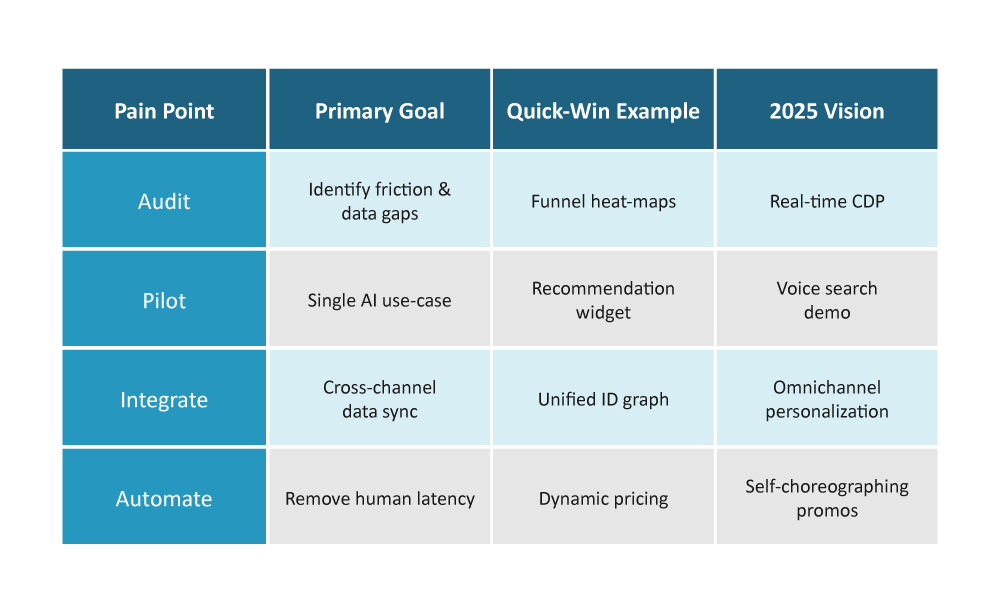How AI for ecommerce is set to transform business in 2025

Highlights:
- Hyper-personalized recommendations now drive up to 35 % of online sales.
- AR, video, and avatars turn static catalogs into immersive buying showrooms.
- AI-driven logistics forecasting slashes stock-outs and shortens delivery zones.
- Real-time dynamic pricing boosts revenue while protecting profit margins.
- GPT-powered chatbots convert 24/7 support chats into seamless sales moments.
- Agentic AI enables autonomous restocking and friction-free repeat purchases.
A decade ago, recommendation widgets and basic chatbots were considered cutting-edge. In 2025, those early experiments look quaint next to the full-stack intelligence now powering digital retail. From hyper-personalized storefronts to warehouses that restock themselves, AI for ecommerce has matured into the new operating system of online retail. The retailers that treat data, algorithms, and automation as core assets—rather than bolt-on features—will define the next era of growth. For every ambitious business, the question is no longer if you should adopt AI for ecommerce, but how quickly you can integrate it and where you’ll gain the biggest advantage with ecommerce with AI.
Precision personalization: The revenue engine
Amazon still sets the pace: up to 35% of its sales flow directly from its AI-powered recommendation engine. Similar machine-learning systems ingest browsing patterns, dwell time, basket history and real-time intent signals to create a bespoke store for every visitor. For brands such as Stitch Fix, algorithms work in tandem with human stylists, raising retention and basket size. In practical terms, AI for ecommerce converts the old “people who bought X also bought Y” into a predictive model that knows what a shopper will want next—and serves it before the impulse fades.
Immersive discovery: AR, video & digital avatars
Rich media is no longer a luxury; it’s a conversion catalyst:
- Sephora’s Virtual Artist lets shoppers try on thousands of shades. Users who engage with this AR tool convert up to 35% more than non-users.
- On Alibaba’s Taobao, AI-generated product videos featuring digital avatars push click-through rates 30% higher, while slashing production time for merchants.
By embedding ecommerce with AI into discovery, retailers turn static catalogues into interactive showrooms—reducing purchase anxiety and increasing basket value.
Supply-chain intelligence: Predict, position, promise
Out-of-stock messages remain a top frustration for customers, but AI for ecommerce is changing the math. Walmart’s AI logistics suite analyses historical sales, local weather patterns and event calendars to forecast demand and reposition inventory weeks ahead of surges. The result: fewer stock-outs, shorter shipping zones and lower freight costs. For any ecommerce business, that operational efficiency translates into capital you can redeploy toward marketing or product innovation.
Dynamic pricing: Protect margin without guesswork
AI-driven pricing engines monitor elasticity, competitor moves and real-time demand, adjusting thousands of SKUs in minutes. Early adopters in ecommerce business report 5–10% revenue lifts while avoiding the margin erosion of blanket discounts. Because models learn continuously, AI for ecommerce can throttle promotions automatically—dropping prices on slow movers or raising them on scarce items—without human latency.
Conversational commerce: Chatbots that sell and support
Modern chatbots are more than FAQ bots; they’re 24-hour sales reps:
- Juniper Research projects chatbots will facilitate $112 billion in annual ecommerce transactions in 2025.
- Retailers deploying GPT-powered assistants have seen 7–25% incremental revenue plus substantial reductions in live-chat costs.
When fashioned as honest, brand-toned advisers, conversational agents exemplify ecommerce with AI—turning every support exchange into a chance to upsell, cross-sell or simply deepen loyalty.
Fraud & risk: Trust at machine speed
Card fraud and account takeovers erode confidence faster than any UX bug. AI fraud suites analyze dozens of signals—IP, device fingerprint, behavioral biometrics—approving legitimate orders and auto-blocking bad actors in milliseconds. This safeguard allows an ecommerce business to keep friction low for genuine buyers while defending the brand’s reputation.
Generative AI: Content creation at scale
Product pages once took hours of copy-editing and localization. Now generative models draft SEO-rich titles, persuasive bullet lists and variant imagery in seconds:
- Alibaba’s generative listing tools let merchants create high-quality product pages almost instantly, cutting manual effort while improving text consistency.
When plugged into editorial workflows, AI for ecommerce becomes both a creative partner and a speed multiplier, freeing staff to focus on higher-value storytelling.
From agentic AI to autonomous commerce
Walmart’s 2025 “Retail Rewired” report highlights Agentic AI—lightweight digital assistants that orchestrate tasks from inventory replenishment to voice-driven basket building. These agents foreshadow a world where shoppers delegate routine purchases to trusted bots. Imagine a refill agent that reorders pet food when weight sensors flag low supply—no clicks required. Forward-looking retailers view this not as a threat but as a loyalty amplifier: whoever powers the agent becomes the default merchant.
Implementation roadmap: From pilot to platform

Approaching AI for ecommerce as a disciplined roadmap—rather than a scattershot checklist—ensures every dollar invested moves key KPIs: conversion, AOV, return rate, CSAT.
Governance & ethics: Guardrails for sustainable growth
Consumers reward relevance but punish creepiness. Make responsibility a feature, not an after-thought:
- Privacy-by-design: Honor consent, minimize data collection.
- Bias audits: Stress-test recommendation models for demographic fairness.
- Explainability dashboards: Equip internal teams to trace why AI made a decision.
Transparent guardrails solidify trust, letting ecommerce business leaders scale AI initiatives without reputational risk.
Four trends to watch
- Edge intelligence at fulfilment – Vision models on handheld scanners flag picking errors instantly, preventing wrong-item ships.
- Federated learning for personalization – On-device training enables hyper-relevance without exporting sensitive data.
- Multimodal commerce – Searches blend text, voice, and image in one query, answered by a single AI layer.
- Carbon-aware AI – Logistics optimizers factor emissions into routing decisions, aligning cost with sustainability goals.
Brands harnessing these trends will cement leadership as ecommerce with AI moves from experimental to expected.
Conclusion – act early, iterate relentlessly
AI is not a silver bullet; it’s a system of small, compounding wins:
- Launch a recommendation pilot → fund a dynamic pricing roll-out.
- Free up working capital → invest in AR or agentic assistants.
- Reinforce with transparent governance → earn durable trust.
In 2025, AI for ecommerce will underpin how products are discovered, priced, fulfilled and remembered. Retailers that start now—and iterate boldly—will turn today’s curiosity into tomorrow’s market share. Partnering with Netscribes accelerates this journey through our ecommerce solutions. With deep expertise in ecommerce data and scalable AI strategy, Netscribes helps you turn complex transformation into measurable, market-moving results.






